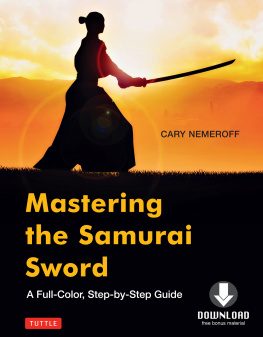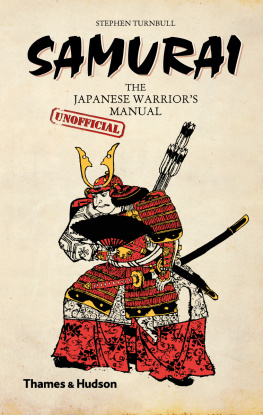Alexander McKay - Scottish Samurai
Here you can read online Alexander McKay - Scottish Samurai full text of the book (entire story) in english for free. Download pdf and epub, get meaning, cover and reviews about this ebook. publisher: Canongate Books, genre: Non-fiction. Description of the work, (preface) as well as reviews are available. Best literature library LitArk.com created for fans of good reading and offers a wide selection of genres:
Romance novel
Science fiction
Adventure
Detective
Science
History
Home and family
Prose
Art
Politics
Computer
Non-fiction
Religion
Business
Children
Humor
Choose a favorite category and find really read worthwhile books. Enjoy immersion in the world of imagination, feel the emotions of the characters or learn something new for yourself, make an fascinating discovery.
- Book:Scottish Samurai
- Author:
- Publisher:Canongate Books
- Genre:
- Rating:3 / 5
- Favourites:Add to favourites
- Your mark:
- 60
- 1
- 2
- 3
- 4
- 5
Scottish Samurai: summary, description and annotation
We offer to read an annotation, description, summary or preface (depends on what the author of the book "Scottish Samurai" wrote himself). If you haven't found the necessary information about the book — write in the comments, we will try to find it.
Scottish Samurai — read online for free the complete book (whole text) full work
Below is the text of the book, divided by pages. System saving the place of the last page read, allows you to conveniently read the book "Scottish Samurai" online for free, without having to search again every time where you left off. Put a bookmark, and you can go to the page where you finished reading at any time.
Font size:
Interval:
Bookmark:

First published in Great Britain in 1993 by Canongate Press Ltd.
Second (enlarged) edition published in 1997 by Canongate Books Ltd,
14 High Street, Edinburgh EHI ITE
This digital edition first published by Canongate in 2012
Copyright Alexander McKay 1993, 1997
All rights reserved. The right of Alexander McKay to be identified as the author of this work has been asserted by him in accordance with the Copyright Designs & Patents Act 1988.
eISBN 978 0 85786 730 8
Typeset by Palimpsest Book Production Limited,
Polmont, Stirlingshire
British Library Cataloguing in Publication Data
A catalogue record for this book is available
on request from the British Library.
www.canongate.tv
To Sachiko, Emi and Mari
PREFACE
T here is a bridge leading into Nagasakis once notorious red-light district of Maruyama which the Japanese call the Shian Bashi or Hesitation Bridge. Further into Maruyama there is a second bridge, Omoikiri Bashi or Made-up-your-Mind Bridge. Presumably when potential patrons of Maruyamas pleasures crossed this second bridge any problems of conscience had been overcome.
The bridges of Maruyama were there long before the return of Western traders to Nagasaki in the late 1850s. The fortune hunters then came in droves when Japans shogun-imposed 200-year isolation from the rest of the world ended and the country was forced into dealing once more with the West.
Among those Western traders was a young man from Aberdeen whose one known weakness was perhaps not pausing long enough at the Hesitation Bridges of Japan. Thomas Blake Glovers arrival in Nagasaki marked the beginning of the rise of Japan from its feudal isolation of the nineteenth century to the economic superpower of today.
Glover arrived in Nagasaki late in 1859 and his rise to fame was a rapid one. He formed his own company in 1861 and took over the highly prestigious Jardine, Matheson & Co. agency in the port at the same time.
The rapid expansion of his newly formed company can be compared with the rise of firms such as Sony and Toyota a hundred years later. But it was the complicated political situation in Japan which provided his first opportunities in business.
Glover was intimately involved in the rebellion of dissatisfied samurai which dominated the 1860s. This uprising brought down the bakufu, the government, nominally led by the shogun, then ruling Japan. He was involved to the extent that in an interview given shortly before his death he claimed for himself the title of the greatest rebel in the movement which brought down the last shogun and restored the Emperor in 1868.
This rebellion, which ended the Tokugawa familys 200-year grip on the office of shogun, is a watershed in Japanese history. The first Tokugawa shogun had been helped into power by Will Adams, the English pilot of a shipwrecked Dutch vessel and the model for Blackthorne in James Clavells historical novel, Shogun. Two centuries later the last Tokugawa shogun was eased out of power by a young Scottish adventurer.
Glover helped the rebels with money, with arms, and with escape and transport to the West. Supplying arms made Glover rich but there is much more to his story than that.
He helped push Japan into the modern world. His Aberdeen-built slip-dock pioneered the Mitsubishi shipyard complex now sited in Nagasaki, one of the most advanced in the world, containing a dry-dock with a capacity of berthing ships of up to 1 million tons. The coal-mine he developed with imported British technology at Takashima, near Nagasaki, fuelled the industrialisation of Japan and its exports provided much of the crucial foreign currency necessary to pay for it. His ships formed the nucleus of the Japanese Navy and Merchant Marine.
In 1908, aged seventy, Glover was awarded the Order of the Rising Sun by the man he had helped to power forty years before Emperor Meiji. The citation for his award lists his achievements for Japan and runs to twenty pages of script.
He died in 1911 at his palatial Tokyo residence. At seventy-three he was a Hero of the New Japan but even to this day he is little known in his own country.
Glovers personal life was as complicated and dramatic as his public one. He had a string of affairs with Japanese women and there are at least four recorded instances of children he fathered to different mothers while in Japan. An affair with the completely unknown Maki Kaga early in 1870 led to the birth of a son and almost certainly some elements of the Madam Butterfly legend.
No family letters are known to have survived although Glovers business dealings in his decade as Jardine, Matheson & Co.s agent are well documented. Yet from all the available sources it is possible to track Glovers life with some accuracy.
This is the story of a Scottish samurai.
FOREWORD
February 2012
I am delighted Canongate are re-issuing Scottish Samurai. There has been recent interest in Glover in the UK by, among others, the BBC and in Japan by its equivalent, NHK, and the book has been out of print for some time. It expresses much of my non-academic excitement at having discovered Thomas Glover in the early 1970s. It had come about almost by accident. While engaged in looking for oil in the Sea of Japan I lived and worked in Japan for almost a decade and married a Japanese girl in 1973. We visited Nagasaki on honeymoon. The book, which had bubbled inside me for years, was written in the years after my permanent return to the UK in the mid-1980s.
This is not a new edition. I must therefore point out that in the years since first publication, extensive scholarship, principally by my good friend Professor Brian Burke-Gaffney of Nagasaki, has shed much more light on the origins of the GloverMadam Butterfly story and those wishing to pursue this particular aspect should access his work on the subject. More details of Glovers son, Tomisaburo, have also emerged but the basic details and the story remain exactly as I wrote them in this book.
Alexander McKay, Edinburgh, February 2012
ACKNOWLEDGEMENTS
F or their patience, encouragement, kindness and help in the writing of this book, I would like to acknowledge the following: in Japan: Brian Burke-Gaffney, Kenji Fujita, Junichi Kusumoto, Hatsuho Naito, Yumiyo Yamamoto; in Belgium: Birgit Debeerst; in The Netherlands: Jan van Rij; in the UK: David G.O. Carmichael, Dr Hazel Carnegie, Sir Hugh Cortazzi, Robin Denniston, Dr John Edward, Dr John McMaster, Anne Malcolm, Loraine Noble, the late Dr Sandy Sharp, Commander Brian Wainwright, Billy Watson; in the USA: Mrs Mabel Bennett. I am grateful, also, to Duncan McAra, for his contribution as editorial consultant.

CHAPTER ONE
THE COASTGUARDS FAMILY
T homas Blake Glovers family background was typically that of the Victorian middle class of north-east Scotland: farming and the sea.
His father, Thomas Berry Glover, who had been born in London, was a naval officer whose career with the Coastguard spanned twenty-seven years. As a newly qualified twenty-two-year-old ships master, he had joined the service in Vauxhall, London, in 1827. The Coastguard was then five years old formed in 1822 from an amalgamation of the various coastal defence and anti-smuggling organisations then in existence. The officers of the new service were nominated by the Lords of the Admiralty. The Coastguards main functions were to prevent smuggling and to give aid to ships in distress. Later its duties were widened to include searching for mines and torpedoes lost at sea, and performing sundry duties in connection with signals, telegraphs, buoys, lighthouses, wild birds and rare fish washed ashore.
Next pageFont size:
Interval:
Bookmark:
Similar books «Scottish Samurai»
Look at similar books to Scottish Samurai. We have selected literature similar in name and meaning in the hope of providing readers with more options to find new, interesting, not yet read works.
Discussion, reviews of the book Scottish Samurai and just readers' own opinions. Leave your comments, write what you think about the work, its meaning or the main characters. Specify what exactly you liked and what you didn't like, and why you think so.











